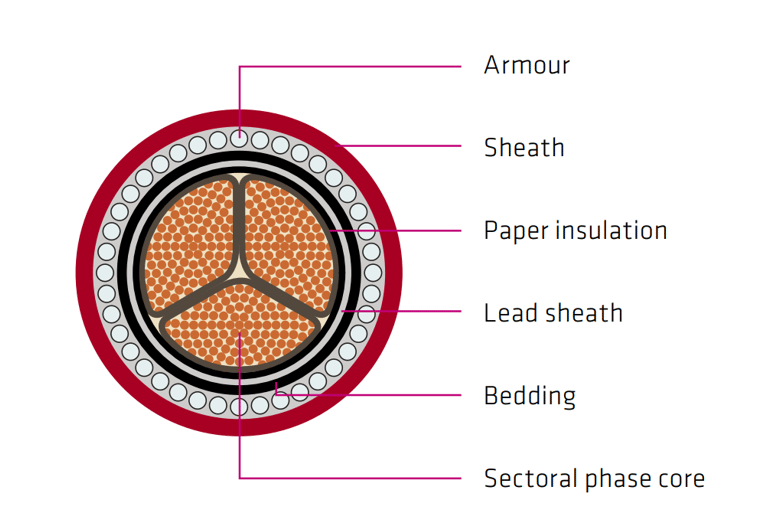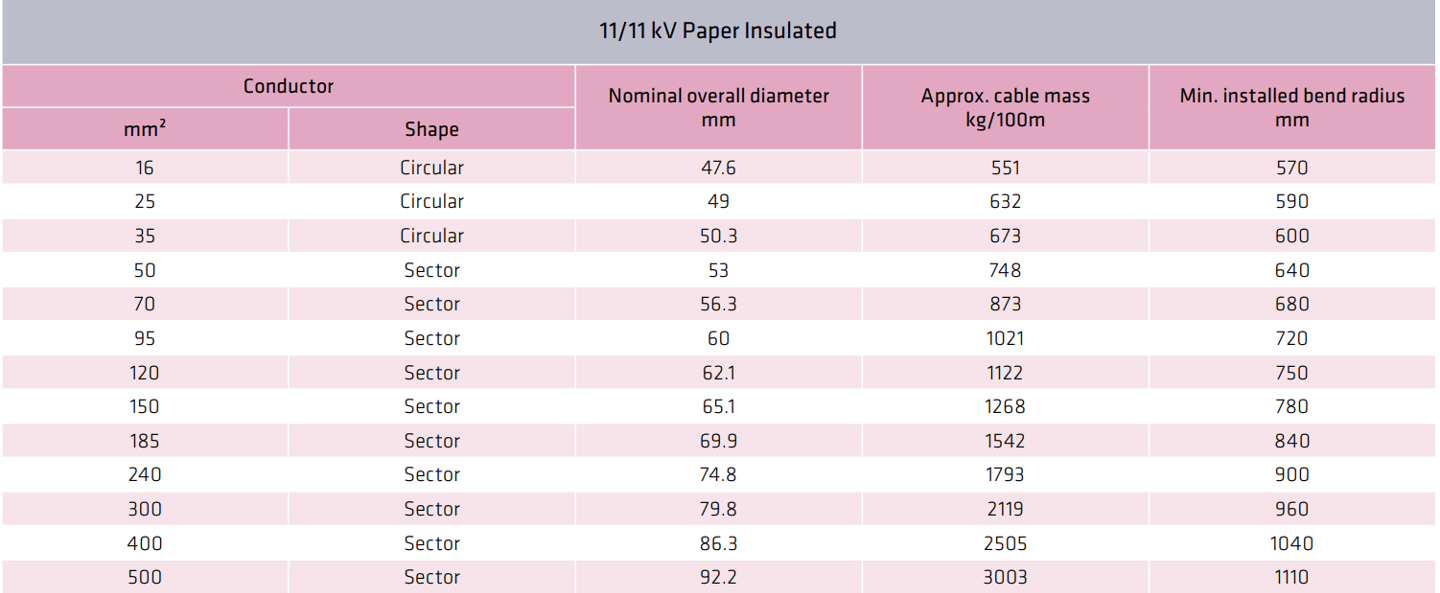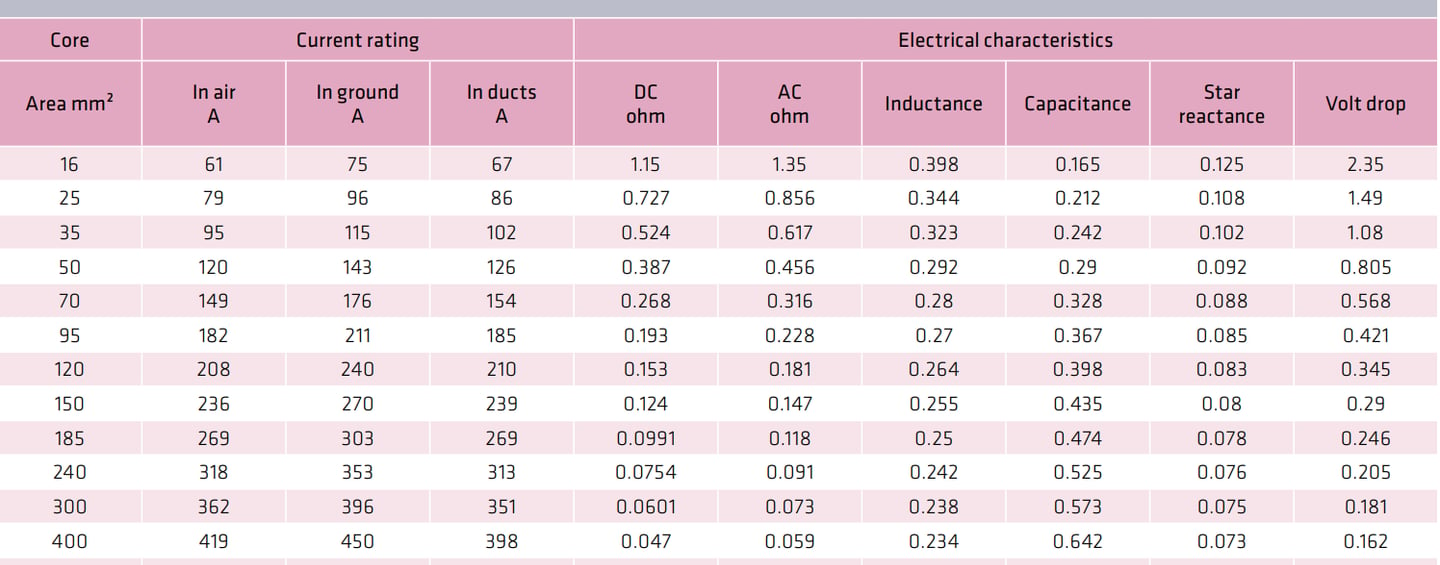📞+86 153 7530 2641 📧 hongjing.Wang@feichuncables.com

11/11 kV Paper Insulated Machine Cables for Mine Power Reticulation | AS/NZS 1972 Belted & Armored Lead-Sheathed Cable
High-performance 11/11 kV paper insulated, paper-belted, lead-sheathed, GSW armored, PVC-sheathed cables engineered to AS/NZS 1972 for reliable primary power reticulation in mines and heavy industrial networks with high earth-fault values.
AS/NZS MINING CABLE
hongjing.Wang@Feichun
8/18/20258 min read


Introduction
Mining operations in Australia and New Zealand demand robust, reliable power distribution systems capable of withstanding harsh underground conditions whilst delivering consistent electrical performance. The 11/11 kV paper insulated cable represents a proven solution for primary mine power reticulation, engineered specifically to meet the stringent requirements of AS/NZS 1972 standards. These specialised cables form the backbone of mining electrical infrastructure, providing essential power distribution throughout underground workings and surface facilities.
The significance of AS/NZS 1972 compliance cannot be overstated in mining applications, where electrical safety and reliability directly impact operational continuity and worker safety. This standard ensures that cables meet rigorous performance criteria for high-voltage applications in demanding industrial environments. The three-core belted paper insulated design offers exceptional dielectric properties and proven long-term reliability, making it an ideal choice for primary supply systems in mines and heavy industrial networks.
These cables serve as high-voltage feeder cables throughout mine power reticulation systems, delivering power from main substations to distribution points across expansive mining operations. Their robust construction enables reliable operation in environments characterised by moisture, chemical exposure, mechanical stress, and temperature variations that would challenge lesser cable designs.
Cable Construction and Materials
Three-Core Belted Paper Insulation
The foundation of the lead-sheathed 11/11 kV paper belted cable for mines lies in its sophisticated insulation system. Each cable features three sectoral phase cores constructed from compacted shaped plain annealed copper conductors, available in nominal cross-sectional areas ranging from 16 mm² to 500 mm². The smaller conductor sizes (16 mm², 25 mm², and 35 mm²) utilise circular conductor shapes, whilst larger sizes from 50 mm² to 500 mm² employ sectoral configurations to optimise space utilisation and enhance electrical performance.
The paper insulation system comprises impregnated paper tape applied to each individually numbered core, with an overall paper tape belt providing additional insulation integrity. This time-tested insulation technology offers superior dielectric strength and thermal stability, with the impregnation process ensuring moisture resistance and enhanced electrical properties. A semiconductive tape screen applied to each conductor core provides uniform electric field distribution, reducing stress concentrations that could lead to premature failure.
The belt insulation design creates a robust barrier between phases whilst maintaining excellent electrical characteristics. This configuration proves particularly advantageous in mining applications where cables may experience mechanical stress, vibration, and environmental challenges that could compromise individual core insulation systems.
Lead Sheath and Galvanised Steel Wire Armor
The lead alloy inner sheath provides exceptional moisture and chemical resistance, forming an impermeable barrier that protects the paper insulation system from groundwater ingress and chemical contamination common in mining environments. Lead sheathing offers superior corrosion resistance compared to alternative metallic sheaths, ensuring long-term reliability even when exposed to aggressive soil conditions or chemical spills.
Galvanised steel wire (GSW) armor provides comprehensive mechanical protection whilst contributing to the cable's electrical safety characteristics. The armor design ensures not less than 50% conductance of the power conductor, creating an effective earth return path that enhances fault protection and reduces earth loop impedances. This feature proves crucial in mining applications where reliable earth-fault protection systems are essential for operational safety.
The GSW armor construction provides exceptional resistance to mechanical impact, crushing forces, and penetration damage that cables may encounter during installation or operation in mine environments. The galvanised coating ensures long-term corrosion resistance, maintaining armor integrity throughout the cable's operational life.
PVC Outer Sheath
The red PVC outer sheath provides the final layer of protection against environmental factors including UV radiation, weather exposure, and mechanical abrasion. This thermoplastic sheath offers excellent resistance to oils, chemicals, and moisture whilst maintaining flexibility across the cable's operating temperature range from 0°C to 65°C maximum operating temperature.
The PVC sheath design makes these cables suitable for direct burial installations, eliminating the need for additional protective conduits in many applications. This capability significantly reduces installation costs whilst providing reliable long-term performance in underground mining environments.
Electrical Characteristics
Rated Voltage and Performance Parameters
The GSW armored high earth-fault value power reticulation cable operates at nominal voltages of 11/11 kV, providing reliable medium-voltage power distribution throughout mining facilities. The cable's electrical characteristics vary according to conductor cross-sectional area, with DC resistance values ranging from 1.15 Ω/km for 16 mm² conductors to 0.0366 Ω/km for 500 mm² conductors at 20°C.
AC resistance values account for skin effect and proximity losses, with values ranging from 1.35 Ω/km for the smallest conductor size to 0.047 Ω/km for the largest. These resistance characteristics directly impact voltage regulation and power loss calculations essential for power system design optimisation.
Reactive Characteristics
Inductance values range from 0.398 mH/km for 16 mm² conductors to 0.229 mH/km for 500 mm² conductors, whilst capacitance increases from 0.165 μF/km to 0.715 μF/km across the same conductor range. These reactive characteristics influence power factor correction requirements and charging current calculations for extended cable runs common in large mining operations.
Star reactance values, critical for fault current calculations, range from 0.125 Ω/km to 0.072 Ω/km. Voltage drop characteristics, expressed as V/A/km, decrease from 2.35 for 16 mm² conductors to 0.149 for 500 mm² conductors, enabling precise voltage regulation calculations for extended distribution circuits.


Thermal and Mechanical Performance
Current-Carrying Capacities
Current-carrying capacity represents a critical performance parameter for mine power reticulation applications. The PVC sheathed paper insulated cable direct burial mining configuration offers varying ampacities depending on installation method. For in-air installations, current ratings range from 61 A for 16 mm² conductors to 481 A for 500 mm² conductors. Direct burial installations provide enhanced cooling, with current ratings ranging from 75 A to 509 A across the conductor size range.
Duct installations, common in mine shaft applications, provide intermediate cooling performance with current ratings from 67 A to 456 A. These thermal ratings account for the cable's maximum operating temperature of 65°C and assume standard installation conditions with appropriate soil thermal resistivity values.
The paper insulation system's excellent thermal characteristics ensure stable performance under frequent chemical exposure conditions typical in mining environments, where cables may encounter oil-based hydraulic fluids, diesel fuel, and various industrial chemicals.
Installation Guidelines
Minimum installed bend radii increase progressively with conductor size, ranging from 570 mm for 16 mm² cables to 1110 mm for 500 mm² cables. These specifications ensure that installation procedures maintain insulation integrity and prevent mechanical damage to the cable structure.
Proper handling procedures during installation require attention to cable mass, which ranges from 551 kg/100m for the smallest cable size to 3003 kg/100m for the largest. Installation crews must utilise appropriate lifting equipment and support systems to prevent damage during cable pulling operations.


Environmental and Application Suitability
Chemical and Environmental Resistance
The cable design provides very good resistance to frequent chemical exposure, making it ideal for mining environments where hydraulic fluids, lubricants, and cleaning chemicals may contact cable surfaces. The lead sheath provides primary chemical resistance, whilst the PVC outer sheath offers additional protection against specific chemical classes.
Direct weather exposure suitability enables surface installations without additional protective measures, reducing installation complexity and costs. The cable construction withstands solar radiation, temperature cycling, and moisture ingress that characterise outdoor mining applications.
Primary Mine Reticulation Applications
These cables serve as the primary power distribution medium for mine electrical systems, delivering power from main substations to secondary distribution points throughout mining operations. Typical applications include power supply to ventilation systems, conveyor drives, pump stations, and underground electrical substations.
The cable's ability to handle high earth-fault values proves particularly valuable in mining applications where earth return paths may vary in resistance due to ground conditions and installation configurations. This characteristic ensures reliable operation of protection systems and maintains electrical safety standards.


Mining Application Scenarios and Common Issues
Typical Installation Scenarios
In underground coal mining operations, these cables typically run from surface substations through main drifts to underground distribution substations. The cables must traverse varying geological conditions, from dry rock formations to areas with significant groundwater presence. Installation depths may exceed 300 metres below surface level, subjecting cables to substantial overburden pressures.
Open-cut mining operations utilise these cables for mobile equipment supply, with installation routes following haul roads and processing areas. The cables must accommodate frequent repositioning as mining operations progress, requiring robust construction and flexible installation methods.


Frequently Asked Questions About Cable Performance Issues
Q: What causes premature failure in paper insulated mine cables?
A: The most common failure mechanisms include moisture ingress through damaged sheaths, mechanical damage from heavy equipment traffic, and insulation degradation due to prolonged overvoltage conditions. The lead sheath provides excellent moisture protection, but physical damage can create ingress points. Regular inspection of cable routes and prompt repair of minor sheath damage prevents major failures.
Q: How does soil chemistry affect cable performance?
A: Aggressive soil conditions with high salt content or industrial contamination can accelerate corrosion of the GSW armor and lead sheath. However, the galvanised coating on the steel wire armor and the inherent corrosion resistance of lead alloy provide excellent long-term protection. In extremely aggressive soil conditions, additional cathodic protection systems may be beneficial.
Q: Why do some installations experience higher than expected voltage drops?
A: Voltage drop issues typically result from inadequate conductor sizing for the actual load conditions or poor termination practices creating additional resistance. The paper insulation system maintains stable electrical characteristics throughout its service life, so increasing voltage drop often indicates external factors such as poor connections or changed load patterns.
Q: What maintenance procedures are recommended for optimal performance?
A: Regular thermal imaging surveys can identify developing hot spots at terminations or joints before they cause failures. Annual insulation resistance testing monitors the integrity of the paper insulation system. Visual inspection of exposed cable sections should check for mechanical damage, particularly around support points and where cables transition between different installation conditions.
Q: How do these cables compare to XLPE alternatives for mining applications?
A: Whilst 12.7/22 kV XLPE cables offer higher temperature ratings and potentially smaller conductor sizes for equivalent current ratings, paper insulated cables provide superior performance in applications with high earth-fault values and harsh chemical environments. The proven track record of paper insulation in mining applications often makes it the preferred choice for critical power distribution circuits.
Conclusion
The 11/11 kV paper insulated cable engineered to AS/NZS 1972 standards represents a mature, proven technology ideally suited for demanding mine power reticulation applications. The combination of paper belt insulation, lead sheath protection, GSW armor, and PVC outer sheath provides comprehensive protection against the environmental challenges characteristic of mining operations.
Compliance with AS/NZS 1972 ensures that these cables meet the rigorous safety and performance requirements essential for mining electrical systems. The extensive range of conductor sizes from 16 mm² to 500 mm² enables system designers to optimise cable selection for specific applications whilst maintaining consistent installation and maintenance procedures.
The superior chemical resistance, mechanical protection, and electrical performance characteristics of this cable design continue to make it the preferred choice for primary mine power distribution systems throughout Australia and New Zealand. For detailed specifications, current ratings, and ordering information tailored to your specific mining power reticulation requirements, contact our technical specialists who can provide comprehensive support for your project planning and implementation needs.
How to Reach Us
Get in Touch
SiteMap
Product Catalogue
Reeling Cable
Festoon Cable
Shore Power Cable




Scan to add us on WeChat
